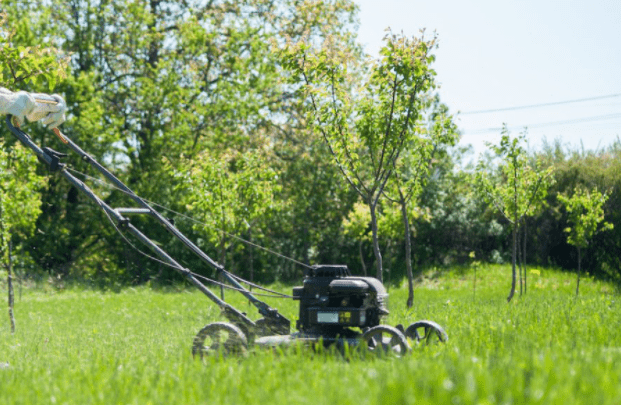Mowing is one of the best practices for achieving a healthy lush lawn. However, lawn mowing has to be done correctly, under the right weather conditions. This brings us to a question; can you cut wet grass?
No, you should not mow grass when it is wet. Mowing in the rain or immediately after running a sprinkler can hurt your grass, damage your lawn mower, and is also unsafe for you as the mower operator.

Can You Cut Wet Grass?
Cutting wet grass is a bad idea, this is not only after a heavy rainstorm but also after running a sprinkler or early in the morning when there is plenty of dew on the lawn. The following are reasons why you should not mow wet grass:
1. Not good for your lawn
Wet grass blades are usually heavy and not standing upright for a perfect cut. It becomes difficult to slice them and achieve a clean cut as would be when the lawn is dry.
Even with newly sharpened or replaced mower blades, it may take you several passes over an area but you will still not get an evenly cut lawn.
Mowing a wet lawn also encourages conditions that promote fungal diseases. Grass clippings clump together and eventually mat down over the grass preventing sunlight and airflow and after some time you will start seeing brown patches in your lawn.
Wet grass clippings that stick to the underside of a mower deck are likely to invite mold that can spread to your lawn. Mold can seriously affect the health and appearance of your lawn and controlling it can be expensive.
After rains or thorough watering, the ground becomes soft, and moving a heavy machine over will typically hurt the lawn. The wheels of a mower will sink into the soft areas not only tearing apart the turf but making your lawn have a groove or furrow-like ruts.
2. It can damage a lawn mower
Moisture or water is a threat to the mower’s metallic parts, fuel tank, and engine or electric motor. Wet grass clippings will stick and cake to the underside of a mower. This will not only cause serious rusting but also an impediment to moving parts such as the blades.
The electric lawn mower can malfunction as a result of a short circuit. Water and electricity do not mix and there are even grave dangers to the mower operator if this happens. There are plenty of connections and sometimes live wires beneath some areas of the machine that can cause danger during mowing wet turf.
Without a proper fuel stabilizer, excessive moisture is likely to contaminate leftover fuel in the tank. This is one of the reasons why your mower may not start.
After cutting wet grass, a mower will require extra cleanup to work efficiently. The deck should be scrapped to get rid of the caked clippings. Brush off the tires and wipe down the body before storing the mower.
3. It can be unsafe for the operator
To begin with, the operator risks electrical shock in the event an electric mower gets exposed to water. There is also the risk of sliding on the slick turf especially if you are mowing on slopes. The worst scenario is sliding yourself into the moving blades of the machine or ending up with a broken limb.
Mowing a wet lawn takes a lot of effort and time. There is little friction and thus no proper traction for the machine tires. More fuel will also be consumed by the machine and the operator will need some muscles to keep the job done.
We should also agree that wet grass stains every surface the clippings hit. This means after mowing you start thorough cleaning of your machine, clothes, and shoes. Cutting wet grass thus makes work harder and more stressful.
How to Mow Wet Grass Safely
There are some instances when you have to mow your lawn regardless of its moisture content. Think about an extended period of rain and the grass is growing taller day in and day out. You have to roll up your sleeves and have your lawn tidy.
Similarly, you have listed your property for sale and you want to attract potential buyers. You may end up mowing your wet grass to put the yard at its aesthetic best.
If that is the case, consider a day when the ground is not really soggy and you are not sinking down into standing puddles. Here are the things you need to do:
- If possible, soak up standing water in the yard as much as you can.
- Add an effective fuel stabilizer to the mower’s gasoline tank.
- Sharpen or replace and balance your mower blades.
- Wear your gardening gear and exercise caution during mowing.
- Set your mower to the side-discharge mode for later manual bagging.
- Raise your mower to cut grass higher than normal to avoid stressing the engine.
- Avoid mulching the grass clippings, discharge them, and rake them into your compost bin.
- Thoroughly clean the underside of the mower’s deck and other areas to remove all stuck clippings.
Final Thought
It is highly recommended to mow grasses when they are dry. The blades will be upright and less likely to clump when cut. Stay informed on weather forecasts to know the ideal day for cutting grass. If you have no otherwise mow your wet grasses cautiously to minimize damage to your lawn, your machine, and also hurting yourself.